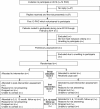Effectiveness of a primary care-based intervention to reduce sitting time in overweight and obese patients (SEDESTACTIV): a randomized controlled trial; rationale and study design
- PMID: 24597534
- PMCID: PMC3973868
- DOI: 10.1186/1471-2458-14-228
Effectiveness of a primary care-based intervention to reduce sitting time in overweight and obese patients (SEDESTACTIV): a randomized controlled trial; rationale and study design
Abstract
Background: There is growing evidence suggesting that prolonged sitting has negative effects on people's weight, chronic diseases and mortality. Interventions to reduce sedentary time can be an effective strategy to increase daily energy expenditure. The purpose of this study is to evaluate the effectiveness of a six-month primary care intervention to reduce daily of sitting time in overweight and mild obese sedentary patients.
Method/design: The study is a randomized controlled trial (RCT). Professionals from thirteen primary health care centers (PHC) will randomly invite to participate mild obese or overweight patients of both gender, aged between 25 and 65 years old, who spend 6 hours at least daily sitting. A total of 232 subjects will be randomly allocated to an intervention (IG) and control group (CG) (116 individuals each group). In addition, 50 subjects with fibromyalgia will be included.Primary outcome is: (1) sitting time using the activPAL device and the Marshall questionnaire. The following parameters will be also assessed: (2) sitting time in work place (Occupational Sitting and Physical Activity Questionnaire), (3) health-related quality of life (EQ-5D), (4) evolution of stage of change (Prochaska and DiClemente's Stages of Change Model), (5) physical inactivity (catalan version of Brief Physical Activity Assessment Tool), (6) number of steps walked (pedometer and activPAL), (7) control based on analysis (triglycerides, total cholesterol, HDL, LDL, glycemia and, glycated haemoglobin in diabetic patients) and (8) blood pressure and anthropometric variables. All parameters will be assessed pre and post intervention and there will be a follow up three, six and twelve months after the intervention. A descriptive analysis of all variables and a multivariate analysis to assess differences among groups will be undertaken. Multivariate analysis will be carried out to assess time changes of dependent variables. All the analysis will be done under the intention to treat principle.
Discussion: If the SEDESTACTIV intervention shows its effectiveness in reducing sitting time, health professionals would have a low-cost intervention tool for sedentary overweight and obese patients management.
Trial registration: A service of the U.S. National Institutes of Health. Developed by the National Library of Medicine. ClinicalTrials.gov NCT01729936.
Figures
References
-
- World Health Organization. Obesity and overweight fact sheet. 2013. http://www.who.int/mediacentre/factsheets/fs311/en/
-
- Smyth S, Heron A. Diabetes and obesity: the twin epidemics. Nat Med. 2006;12(Suppl 1):75–80. - PubMed
-
- Expert panel on integrated guidelines for cardiovascular health and risk reduction in children and adolescents. 2012. http://www.nhlbi.nih.gov/guidelines/cvd_ped/peds_guidelines_full.pdf. - PMC - PubMed
Publication types
MeSH terms
Associated data
LinkOut - more resources
Full Text Sources
Other Literature Sources
Medical


